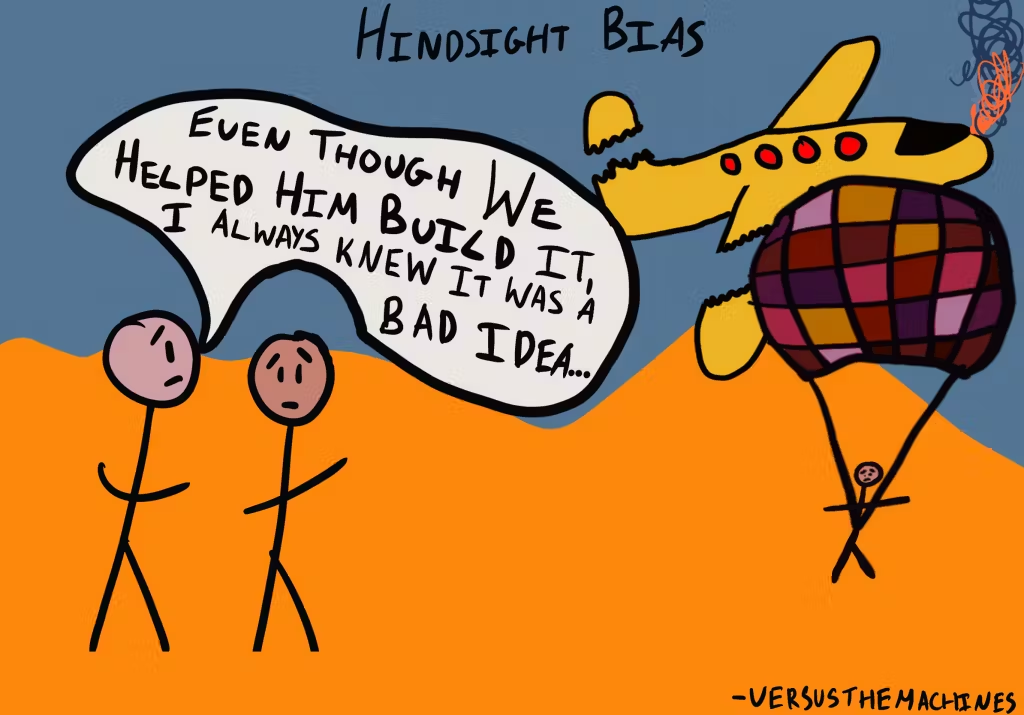Why do unpredictable events only seem predictable after they occur?
Hindsight Bias
, explained.What is the Hindsight Bias?
The hindsight bias describes our tendency to look back at an unpredictable event and think it was easily predictable. It is also called the “knew-it-all-along” effect.

Where this bias occurs
Consider this hypothetical: John and Jane have a fantastic relationship. They are madly in love and even have plans to move in together in a few months—at least that’s what John thinks.
One day after work, John receives a message from Jane: “We need to talk.” Suddenly, he gets worried. Is everything alright? Does Jane still love him? After all, he did pick up on some tension between them over the last few weeks. When they talk later that day, John learns that Jane is not so happy with the relationship. She needs a break from John.
He knew it! John tells himself and his friends. Now that he looks back at his relationship with Jane, he saw many signs that pointed to trouble: canceled plans, awkwardness, being ignored by her friends, and so forth. He had known it all along, and so this bad news from Jane was actually no surprise to him.
This is the hindsight bias at work. An unforeseen break-up becomes foreseeable to John only after it takes place. He overestimates his ability to have predicted the end of his relationship with Jane once the relationship is suddenly over.
Debias Your Organization
Most of us work & live in environments that aren’t optimized for solid decision-making. We work with organizations of all kinds to identify sources of cognitive bias & develop tailored solutions.
Related Biases
Individual effects
The hindsight bias can have a negative influence on our decision-making. Part of what goes into making good decisions is realistically assessing their consequences. If we look back at past decisions and conclude that their outcomes were indeed known to us at the time (when they weren’t), then it makes sense that we will overestimate our ability to foresee the implications of our future decisions. This can be dangerous, as our overconfidence may lead us to take unnecessary risks.1 Think of a gambler who looks back at past losses as predictable, making him increasingly confident that his next trip to the casino will be successful.
Systemic effects
The hindsight bias can have troubling implications across different academic and professional areas. The accurate study of historical and political events may be tainted if researchers can’t put themselves in the shoes of decision-makers at that time—whose decisions weren’t informed by the foresight we have studying them today. This can cause details that seem obvious after the fact to be overlooked. Law, insurance, and finance are fields that all rely on realistic risk assessments based on similar past events, which the hindsight bias can distort.
How it affects product
When users reflect on their experiences with a digital product, the hindsight bias can lead them to believe that they predicted defects from the beginning—ranging from the layout not feeling quite right to the system frequently crashing. This certainty might skew users’ feedback, making it less about initial impressions or learning curves and more about their post-experience rationalizations. This bias can result in less constructive feedback, impacting the product's iterative improvement process.
The hindsight bias and AI
After the outcomes of AI decisions are known, the hindsight bias can lead people to believe that they knew it all along, as if machine learning predictions are obvious or inevitable. This can lead to an overestimation of the AI's predictability and underestimation of its complexity, potentially causing overreliance on AI in critical decision-making situations.
Why it happens
The hindsight bias happens when new information surrounding a past experience changes our recollection of that experience from an original thought into something different.2 According to psychologists Neal Roese and Kathleen Vohs, there are three stacking levels of which this can occur.
The first level is “memory distortion.” This involves misremembering a past judgment or opinion. We often do this when claiming we said something when we didn’t. The second level is centered around our belief that a past event was inevitable. Roese and Vohs call this degree of the hindsight bias “inevitability.” The last level, “foreseeability,” entails believing that we could have foreseen the event.3 So, the bias occurs when we misremember our past thoughts, think a past event was inevitable, and subsequently, believe the event was foreseeable.
From their review of the existing literature, Roese and Vohs conclude that there are three main variables that affect the three levels of the hindsight bias to create our tendency to overestimate our predictive abilities:
- Cognitive: We often distort our memory of past events by selectively remembering information that confirms what we already now know to be true. We do this to create a story that makes sense with the information we already have in what’s known as “sensemaking.” This is related to the confirmation bias.
- Metacognitive: Metacognition is when we think about our thoughts themselves. When we find it easy to think and understand a past judgment or event, we might confuse ease with certainty. It is often easy to understand how or why an event happened in retrospect, due, at least in part, to the availability heuristic. This makes us certain that we had this understanding before.
- Motivational: It brings us comfort to think that the world has order. This can motivate us to see unpredictable events as predictable. It also feels nice to think that your predictions were right or that you knew it all along even if you might not have. Research shows that our actions are often subconsciously motivated to promote a positive view of ourselves.4,5
Why it is important
It is important that we are aware of the implications the hindsight bias can have on our lives. As mentioned earlier, this bias gets in the way by distorting the internal track-record we have of our past predictions. This can lead to overly confident future predictions that justify risky decisions with bad outcomes in both our personal and professional lives.
More broadly, the hindsight bias prevents us from learning from our experiences. If we already feel that we knew something all along, it is unlikely that we will carefully reflect on its outcome, and it will certainly prevent us from understanding why our predictions at the time might have been wrong. Ultimately, this can prevent us from understanding the true nature of an event or from identifying issues in how we make predictions.
If you feel like you knew it all along, it means you won’t stop to examine why something really happened...“It’s often hard to convince seasoned decision makers that they might fall prey to hindsight bias.”
- Neal Roese, expert in psychology of judgment and decision-making
How to avoid it
One way that Roese and Vohs suggest counteracting the hindsight bias is to consider and explain how the outcomes that did not unfold could have unfolded. By mentally reviewing all the potential outcomes, an event will seem less inevitable and foreseeable. However, Roese and Vohs note that we should not look to consider an overwhelming number of alternative outcomes, as the decision-maker could misinterpret this difficulty as an indication of their implausibility rather than their sheer number.6
Another way of addressing dangerous overconfidence is to keep track of your past decisions and their associated predictions. This can be done in what’s known as a “decision journal,” which is similar to a diary but with details your decisions and what you were thinking when you made them.7 Having an unalterable track record of the predictions associated with your decisions (which will surely show some false predictions) might prevent the mistake of thinking you always knew it all along.
How it all started
While the “knew-it-all-along” phenomenon is not new, its formal scientific study started in the early 1970s. Baruch Fischhoff was the first to study the hindsight bias experimentally, motivated by the seminal work of his supervisors, Daniel Kahneman and Amos Tversky, on heuristics. Fischhoff was also inspired by an article by Paul Meehl on doctors exaggerating their feeling of having known all along how their patient cases were going to turn out.
Interested in the phenomenon and its application to the predictability of political events in retrospect, Fischhoff joined with researcher Ruth Beyth-Marom to test his hypothesis in 1975. To do this, Fischhoff and Beyth-Marom asked participants to predict how likely the various outcomes to then U.S. President Nixon’s upcoming trip to China and the Soviet Union were.
Once Nixon had finished the trip, Fischhoff and Beyth-Marom asked participants to recall their initial predictions. The results showed that participants did not stick to the predictions they made before the trip, but instead gravitated towards the real outcomes of the trip. In other words, they recalled their predictions differently, favoring outcomes they knew were true in retrospect. This study inspired a broader scientific inquiry into the hindsight bias.8
Example 1 – Political predictions
It is not uncommon to hear people claim that they predicted the outcome of political elections beforehand. Researchers Dorothee Dietrich and Matthew Olson conducted a study in 1993 to evaluate the extent to which voters alter their predictions following an election.
Dietrich and Olson asked 57 college students at Hamline University to predict how the U.S. Senate would vote on the confirmation of Supreme Court nominee Clarence Thomas. More specifically, participants were asked to predict the outcome of the vote, how it would be split between parties in the Senate, and to indicate how confident they were in their prediction. A month after the vote, participants were then asked to recall their predictions and level of confidence.9
The results supported the influence of the hindsight bias: before the Senate vote, 58% of students predicted that Thomas would be confirmed. But when students were questioned after the successful confirmation, 78% of them claimed that they had correctly predicted that Thomas would be approved.10
Example 2 – Blaming victims
In both the court of law and public opinion, the hindsight bias may play a role in “victim-blaming.” As mentioned above, part of the reason why this bias arises is that we often look for the easiest explanations and predictions in order to quickly make sense of the world. It is easier to focus on individuals and their actions over more nuanced, systemic causes. It is also easy to form and support predictions for events that have already occurred.
This may explain the prevalence of victim-blaming in cases involving sexual assault. Victims or survivors of such cases are often blamed for their affliction using the rationale “they should have known better” in retrospect. Indeed, studies have shown that this bias contributes to victim derogation in rape cases.
Summary
What it is
The hindsight bias describes our tendency to look back at an event that we could not predict at the time and think the outcome was easily predictable. It is also called the “knew-it-all-along” effect.
Why it happens
First, we often distort our memory of past events by selectively remembering information that confirms what we already know to be true. This is done to create a story that makes sense with the information we already have in what’s known as “sensemaking.”
Second, when people find it easy to think and understand a past judgment or event, they can confuse ease with certainty. It is often easy to understand how or why an event happened in retrospect. This makes us certain that it is an understanding we had before.
Third, it brings us comfort to think that the world is orderly. This can motivate us to see unpredictable events as predictable. It feels good to think that you knew it all along even if you might not have.
Example #1 - Political predictions
A 1993 study asking college students to predict how the U.S. Senate would vote on the confirmation of a Supreme Court nominee supported the influence of the hindsight bias. Before the Senate vote, 58% of students predicted that Thomas would be confirmed. But when students were questioned after the successful confirmation, 78% of them claimed that they originally thought Thomas would be approved.
Example #2 - Blaming victims
The hindsight bias may have a role to play in the victim blaming prevalent in sexual assault cases, since people believe survivors should have “known better” in retrospect. Research suggests that hindsight bias contributes to victim derogation in rape cases.
How to avoid it
One way to avoid the hindsight bias is to consider and explain how the outcomes that did not unfold could have unfolded. By mentally reviewing all the potential outcomes, an event will seem less inevitable and foreseeable.
Another strategy is to keep track of your past decisions and their associated predictions. Having an explicit and unalterable track record of the predictions associated with your decisions (which will surely show some false predictions) might prevent the mistake of thinking you always knew it all along.
Related TDL articles
“If Only”: The Good and the Bad of Counterfactuals
In this article, staff writer Kaylee Somerville breaks down the pros and cons of counterfactuals: thoughts about how past scenarios could have gone differently. Somerville explains that when left unchecked, counterfactual thinking can lead us to fall victim to biases such as the hindsight bias.

